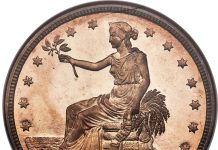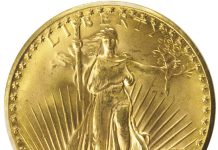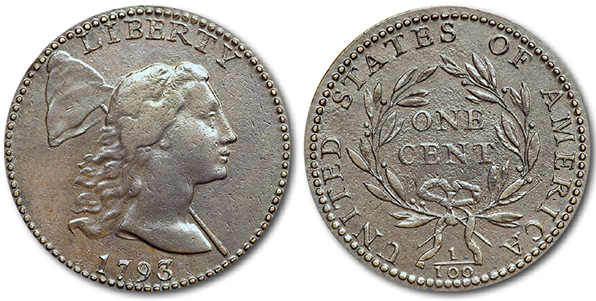
By R.W. Julian
When the Philadelphia Mint began operations in early 1793, the first coins were something new for the country. The copper coins issued to the public were on the decimal system, not the long-standing British way of pounds, shillings, and pence. It was but one more sign that the Colonial period was coming to an end and the United States was now forging ahead on a new path.
One of the attractions of these early copper coins to modern collectors is the knowledge that the coins are very far removed from the present-day world of computers and credit cards. In 1793, the real world meant coins of full value, so that the average citizen was protected in his financial dealings.
When coin collecting became a national interest in the mid-1850s, collectors at first searched for the older copper coins. The Liberty Cap cents of 1793-1795 were a primary target and individuals asked many a bank for the privilege of going through stocks of copper coins.
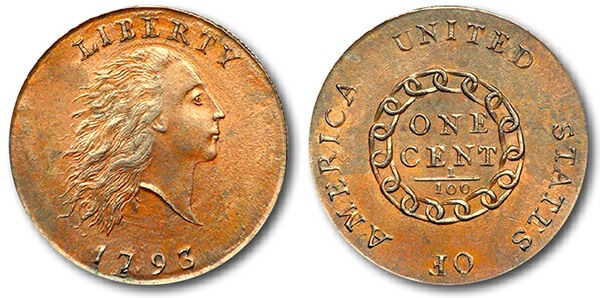
The Liberty Cap cents are not only coins with an inherent beauty unto themselves, but there is very interesting numismatic story behind them. It all began in the early days of 1793. The first regular copper coinage of the United States, the Chain cent, was first coined in late February 1793, perhaps on Washington’s birthday, the 22nd, as a way of honoring his interest in the Mint. Chief Coiner Henry Voight, because there was no regular engraver, prepared the dies for the Chain cents, and the results show that he was not all that skilled in engraving.
There was public criticism of the Chain design, the chain on the reverse supposedly reminding people of British rule prior to 1776. Both sides of the cent got new artwork in early April, with an improved head of Liberty on the obverse and a simple wreath on the reverse. Again, Voight was forced to design the dies, although he had some help from an employee of the coining department. This new design was not all that popular either, but at least did not receive the criticism leveled against the Chain cent.
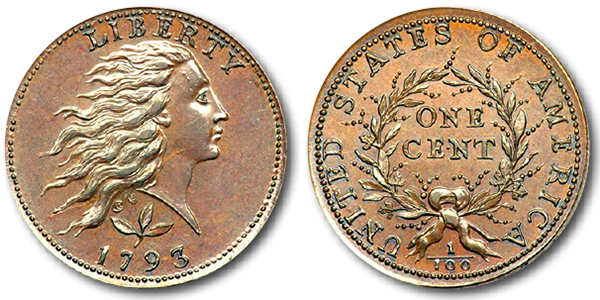
The last Flowing Hair cents, wreath reverse, were coined in June 1793, and for the time being nothing further happened. Director David Rittenhouse was clearly uncertain how to proceed at this point, given that Voight was not the best of choices for engraver.
In July 1793, the Mint coined half cents, again from dies by the chief coiner but it was a swan song for his engraving work.
Sometime during mid- to late-August, the exact date being lost, the Mint finally obtained the services of a skilled engraver, Joseph Wright. It is not at all clear under what conditions he joined the Mint, as there are no pay records for his services nor was his name submitted for Senate confirmation. On the other hand, after his death in September 1793 he was referred to by President Washington as the former engraver of the Mint.
Wright’s first task was to execute dies for a new cent coinage. It is generally agreed that the famous Libertas Americana medal, designed by Benjamin Franklin and executed at the Paris Mint in the early 1780s to celebrate the American victory in the Revolutionary War, was the primary model for Wright’s new head of Liberty. However, he made minor changes and slightly altered the angle of the head.
The reverse wreath on the new cent, although similar to that designed by Voight in March for the Wreath cent, is nevertheless much cleaner in concept, without all the busy details and fine lines that marred the earlier work. Wright’s Liberty Cap design thus provided the American public with something quite new and well done, considering the conditions under which the early mint operated.
Throughout August 1793, Chief Coiner Voight struggled to produce a reasonable number of cent and half cent planchets with which to resume coinage. There was plenty of copper on hand, enough for tens of thousands of coins, but it was the remains of the copper that had been used for earlier cent and half cent coins. When copper is melted and rolled out more than once, it becomes difficult to work, and this slows down coinage operations.

Towards the beginning of September, Voight managed to put together enough planchets for a small mintage run which lasted only for a few days. On September 18th, the coiner delivered 11,056 Liberty Cap cents, all that were ever to be coined with the 1793 date. The Sept. 18 delivery probably covers the coinage of several days of striking, and it is not clear just when the Liberty Cap cents were actually struck nor is it certain that Wright, who died about September 13th from the Yellow Fever epidemic then raging in Philadelphia, saw more than a few trial pieces of his new design. Standard references, such as A Guide Book of U.S. Coins, give the 1793 Liberty Cap cent a value of about $35,000 in VF-20.
There is a strong demand among copper specialists for the 1793 coinage, and the past few years have seen a strong increase in the value of such coins, the 1793 Liberty Cap cent in particular. High-grade specimens are in very strong demand from copper specialists.
Many of the existing copper coins from the 1790s, including the Liberty Cap cent, exhibit another curiosity occasionally seen with U.S. silver coins. They were purchased in England from coin dealers or antique shops. Many tourists from that country, who travelled in America during the 1790s, took home souvenir coins which became valuable when sold by their descendants several generations later. The superb Lord St. Oswald 1794 silver dollar, for example, is well known to specialists. Once the delivery of September 18th had been made by the chief coiner, the Mint shut its doors and all fled for their lives. The source of the Yellow Fever was then unknown but the medical practice of bleeding patients only made matters worse.
In early November, the Mint reopened, and the institution soon saw the arrival of a new engraver, Robert Scot. The replacement for Wright was not skilled at cutting coinage dies, although he was the best talent available at the moment. He was to serve the Mint faithfully until his death in late 1823. In the process, he became a talented member of the staff. Scot first familiarized himself with the duties facing him and then learned to execute dies for coinage, a careful and demanding task.
The chief coiner also spent the remaining weeks of 1793 putting his machinery in order as it was liable to frequent breakdowns. The gearing on the rolling mills, for example, was made of copper and subject to breaking without warning, but at least the replacement parts could be cast anew with a minimum of difficulty.
Cent coinage resumed in January 1794 with dies made by Scot but which used the head punch executed by Joseph Wright for the 1793 coinage. These dies were used in January and February 1794 and are generally referred to by numismatists as the “Head of 1793” coins. Such pieces are eagerly sought by copper collectors and bring high prices when offered in superior condition.
The 1794 with Head of 1793 has a book value of about $5,000 in VF-20 and even in Good-4 the collector may have to pay several hundred dollars for a specimen. Many of these coins are porous, however, and somewhat unsightly in appearance. Those who specialize in early cents generally try to avoid this kind of surface. Scot then engraved his own head punches for the cents of 1794, but each working die was usually retouched by hand to bring up details not found in the hubs. Hubs, or punches as they are sometimes called, have the details of the Liberty head or wreath in relief and are punched into a softened piece of steel to create a working die.
Several of the dies for the 1794 cents have been attributed by modern numismatic researchers to assistant engravers such as John Smith Gardner, who served at the Mint from the latter part of 1794 until his resignation in 1796. Such attributions, however, are unlikely, and it is a near certainty that Robert Scot prepared all of the working hubs, Gardner merely preparing the working dies as needed.
Ordinary cents of 1794 are worth about $2,000 in VF-20 and nearly $4,000 in XF-40. There are dozens of varieties of the 1794 cents, and several eminent collectors, such as John Adams, have specialized in just this one date. More than a century ago, pioneer numismatists gave names, some humorous, to many of the varieties, such as Office Boy Reverse, Fallen 4, and Split Pole.
Most early cent specialists today use the work Penny Whimsy written by Dr. William H. Sheldon, with strong input from Walter Breen. All of the early cents have thus been numbered, and when discussing a particular variety, modern collectors normally use the Sheldon number rather than speaking of any special attributes of the coin.
The most interesting of the 1794 cents is the famous starred reverse (Sheldon 48). Ninety-four tiny stars were punched around the periphery on the reverse and then later partially blocked out by the usual dentils on the border. Considering that the year was 1794, it has been speculated with good reason that the 94 stars were an anti-counterfeiting device that was abandoned as impractical in mass coinage. Reverses could only have been used in the given year had that system been adopted. Starred reverse cents of 1794 bring strong prices due to the fact that they are very rare. The prices of such coins are not for the faint of heart or low-balance bank account. In the grade of Good-4, the tab is usually between $20,000 and $25,000, even assuming that a specimen can be found. One of the nicest pieces, nearly uncirculated, came from the Lord St. Oswald collection and today is the prized member of a private collection.
Cent coinage fell off towards the summer and fall of 1794 as the Mint prepared to begin regular silver coinage. Dollars were first coined in October 1794, followed by half dollars in late November. Due to a problem with the silver coinage in December, however, there was a small coinage of cents in December 1794 to meet an ongoing demand that existed for this denomination during the early years. During most of 1795 there was no copper coinage. The Mint concentrated on silver for the first few months (through the middle of July) and both silver and gold for the remaining months. This left little room for copper coinage and it was not until the arrival of Henry William DeSaussure as director in July, replacing David Rittenhouse, that copper coinage was once more considered.
There does exist a small coinage of cents struck during the opening weeks of 1795, but they were not made in the Mint. Instead, these pieces were struck by John Harper in an effort to get a private contract for striking cents. In the late nineteenth century, collectors saw a resemblance of the Liberty head to Thomas Jefferson, and since that time they have had the nickname of “Jefferson Head” cents. These pieces by Harper are very rare and in great demand from copper specialists.
During the opening months of 1795, the Mint officers had avoided copper not only because of the precious metals coinage but because copper was very hard on the rollers. The rollers were also used to flatten the silver and gold ingots and Rittenhouse ordered that the precious metals take precedence over copper; he really had little choice in the matter if the Mint was to survive its many critics.
DeSaussure, under pressure from all quarters, decided that copper coinage had to resume, even if there was danger to the rollers. To this end, he ordered the chief coiner, probably in late September, to execute a coinage of copper. On Oct. 27, several thousand half cents and 37,000 cents were delivered.
The Oct. 27 cents are special in that this was the only 1795 coinage of cents on the standard of 1793, 208 grains (13.48 grams). All of these coins have lettered edges (“One Hundred for a Dollar”) as well. For some unknown reason, the 1795 lettered-edge cents are not nearly as rare as the tiny mintage would indicate and in XF-40 these are worth about $3,000.
At the same time, as the Oct. 27 delivery of copper, DeSaussure resigned his post and was succeeded by Elias Boudinot. The new director ordered an additional coinage of copper, delivered in early December, but it was composed entirely of half cents. He also took a close look at the copper coinage and found that the cost of raw copper was so high that the government was losing money when cents and half cents were coined on the standard of 1793.
Director Boudinot recommended to President Washington that the weight of the copper coins be reduced and the President did just that, in an executive order of late December 1795. The new standard was 168 grains (10.98 grams) for the cent and half that much for the half cent. Striking of the thinner, planchets began almost immediately but the new coinage does not have lettered edges, making it easy to distinguish from the October mintage. The value of the plain-edged 1795 cents is about the same as the lettered-edge pieces. Cent dies of 1795 were used for several weeks into 1796.
It is not quite clear when the coinage of 1796-dated Liberty Cap cents actually began, but early May has been suggested, and this may well be correct. About 500,000 plain-edged Liberty Cap pieces were made in 1796 but only about 100,000 of them were actually dated 1796.
The 1796 Liberty Caps are worth somewhat more than the 1795s, with an XF-40 booking in current numismatic references at about $6,500. In VG-8 this figure drops to $900. The Liberty Cap cents were last struck in June 1796; after this, the government decided that the copper coinage was to have the same Draped Bust head of Liberty that was currently found on the silver coinage. The Wright design had breathed its last, but his copper cents would circulate for many decades in the United States.
Once the Liberty Cap cent coinage had ended, only the dedicated collector was left to appreciate this fine design and its importance in early U.S. monetary history.
Want to receive COINage magazine in your mailbox or inbox? Subscribe today!



